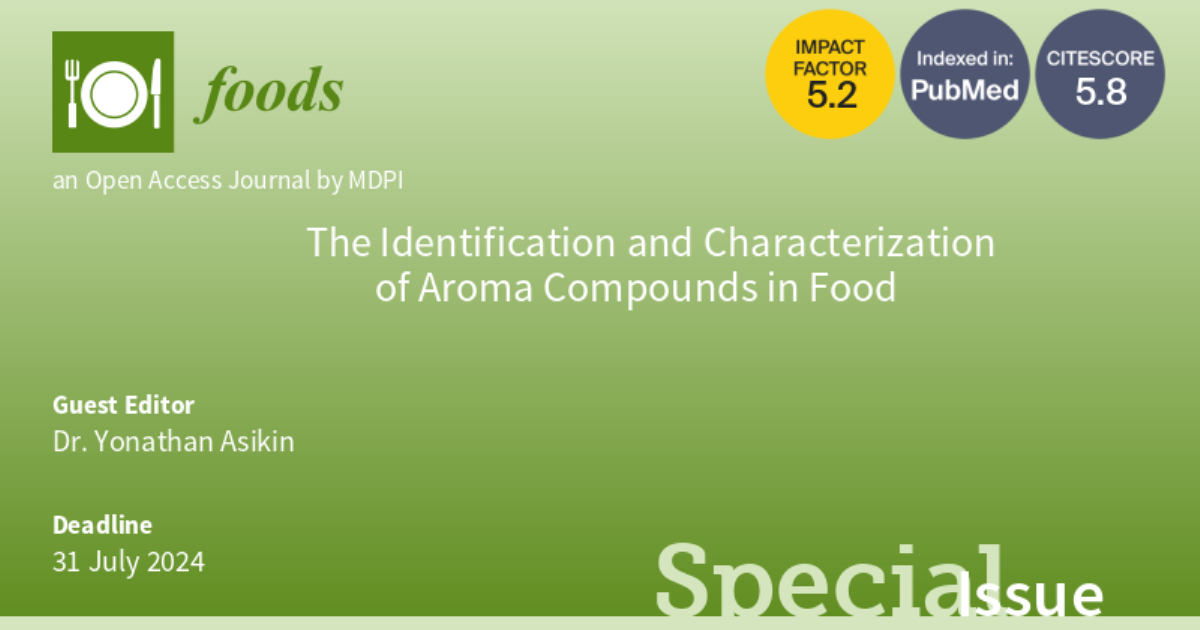The Identification and Characterization of Aroma Compounds in Food
A special issue of Foods (ISSN 2304-8158). This special issue belongs to the section "Food Physics and (Bio)Chemistry".
Deadline for manuscript submissions: closed (31 July 2024) | Viewed by 6858

Special Issue Editor
Special Issue Information
Dear Colleagues,
Aroma is one of the key factors used for determining food quality. Hence, various aroma compounds play an indispensable role in modern food production. They consist of complex chemical classes of volatiles; therefore, regular updates on the research progression of the identification and characterization of these compounds are necessary.
This Special Issue welcomes original research and review articles related to aroma compounds in food. This Special Issue aims to showcase new insights relating to volatile aroma compounds in food, including chemical and aroma-active composition, odor release in retronasal olfaction, flavor masking and modification, and aroma interaction in food and beverage pairings. Combined instrumental and sensory measurements on both taste and aroma attributes that define the quality of raw agricultural commodities and/or processed foods are also welcomed. In addition, the incorporation of statistical computation, such as chemometrics and omics approaches, is encouraged to enhance the multivariate graphical overview in data analysis, if applicable.
I look forward to receiving your contributions.
Dr. Yonathan Asikin
Guest Editor
Manuscript Submission Information
Manuscripts should be submitted online at www.mdpi.com by registering and logging in to this website. Once you are registered, click here to go to the submission form. Manuscripts can be submitted until the deadline. All submissions that pass pre-check are peer-reviewed. Accepted papers will be published continuously in the journal (as soon as accepted) and will be listed together on the special issue website. Research articles, review articles as well as short communications are invited. For planned papers, a title and short abstract (about 100 words) can be sent to the Editorial Office for announcement on this website.
Submitted manuscripts should not have been published previously, nor be under consideration for publication elsewhere (except conference proceedings papers). All manuscripts are thoroughly refereed through a single-blind peer-review process. A guide for authors and other relevant information for submission of manuscripts is available on the Instructions for Authors page. Foods is an international peer-reviewed open access semimonthly journal published by MDPI.
Please visit the Instructions for Authors page before submitting a manuscript. The Article Processing Charge (APC) for publication in this open access journal is 2900 CHF (Swiss Francs). Submitted papers should be well formatted and use good English. Authors may use MDPI's English editing service prior to publication or during author revisions.
Keywords
- volatile aroma composition
- aroma-active compound
- retronasal aroma
- flavor release
- flavor masking
- food pairing
- sensory evaluation
- food quality
- processing technology
- chemometrics and omics
Benefits of Publishing in a Special Issue
- Ease of navigation: Grouping papers by topic helps scholars navigate broad scope journals more efficiently.
- Greater discoverability: Special Issues support the reach and impact of scientific research. Articles in Special Issues are more discoverable and cited more frequently.
- Expansion of research network: Special Issues facilitate connections among authors, fostering scientific collaborations.
- External promotion: Articles in Special Issues are often promoted through the journal's social media, increasing their visibility.
- e-Book format: Special Issues with more than 10 articles can be published as dedicated e-books, ensuring wide and rapid dissemination.
Further information on MDPI's Special Issue polices can be found here.






